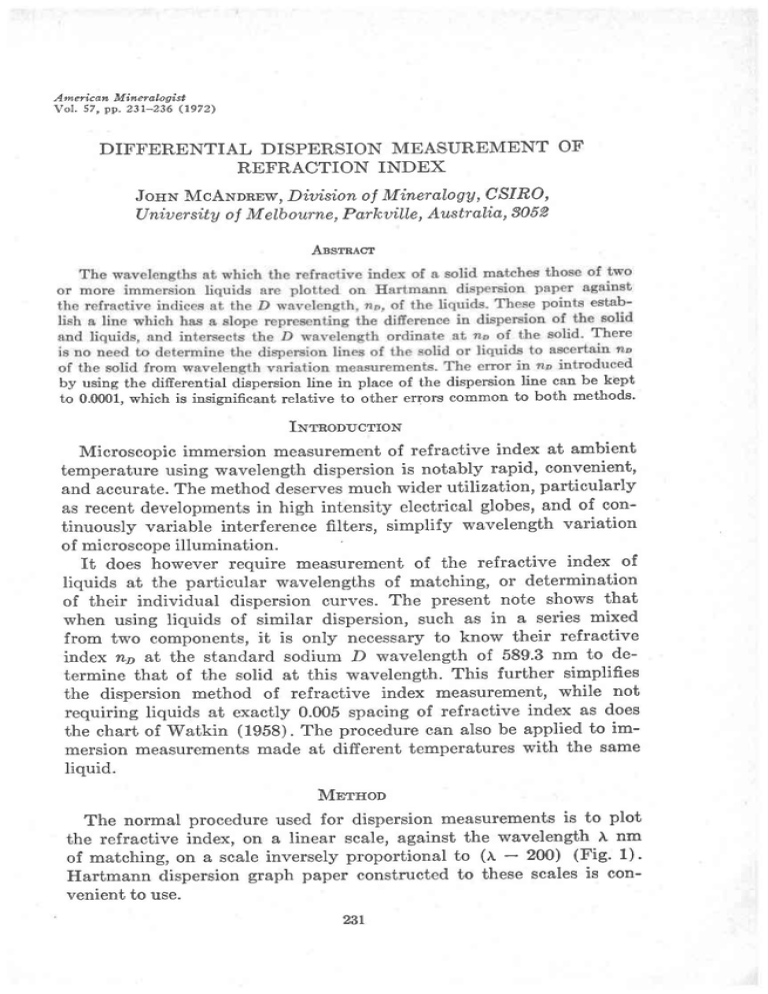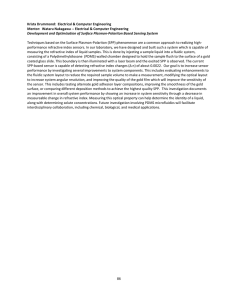DIFFERENTIAL DISPERSION MEASUREMENT OF REFRACTION
advertisement

American Mineralogist Vol. 57, pp. 237-236(7972) DIFFERENTIAL DISPERSION MEASUREMENT OF REFRACTION INDEX JonN McAwDREw, Diuision ol MineralogA,Cffno' Uniu ersitg oI M elbourne, Parlt uille, Awstral;ia,3052 Assrnect by using the difierential dispersion line in place of the dispers'ionline can be kept to 0.0001,which is insignificant relative to other errors common to both methods. INrnonucrroN Microscopicimmersionmeasurementof refractive index at ambient temperature using wavelength dispersionis notably rapid, convenient, much wider utilization, particularly and accurate.The methoddeserves as recentdevelopmentsin high intensity electricalglobes,and of continuously variable interferencefilters, simplify wavelengthvariation illumination. of microscope It does however require measurementof the refractive index of liquids at the particular wavelengthsof matching' or determination of their individual dispersioncurves. The present note shows that when using liquids of similar dispersion,such as in a seriesmixed from two components,it is only necessaryto know their refractive index n;l at the standard sodium D wavelengthof 589.3nm to determine that of the solid at this wavelength.This further simplifies the dispersionmethod of refractive index measurement,while not requiring liquids at exactly 0.005spacingof refractive index as does the chart of Watkin (1958). The procedurecan also be appliedto immade at different temperatureswith the same mersionmeasurements liquid. Mnrrror is to plot The normal procedureused for dispersionmeasurements the refractive index, on a linear scale,against the wavelengthtr nm of matching,on a scaleinverselyproportionalto (r, - 200) (Fig. 1). Hartmann dispersiongraph paper eonstructedto these scalesis convenientto use. 231 232 JOHN MIANDREW X o z F o UI WAVELENGTH Frc. l. Dispersionline and difierential dispersionline of xenotime o. A different procedureis to plot on Hartmann paper np of the liquids against,the actual wavelength at which the solid matches them. The line through these points representsthe differential dispersionof the solid and liquids and intersectsthe standardD wavelength aL np of.the solid, as of coursedoesthe dispersioncurve (Fig. 1). The differential dispersioncurve is sufficientlycloseto a straight line to determinenp to within 0.001by linear interpolationor extrapolation from two suitably locatedpoints on it. Only nn of.!,heliquids needbe measuredto determinethis differentialdispersioncurve,avoiding the refractometryof the liquids at varying wavelengthswhich is normally used in locating the dispersioncurve of the solid. A straight differential dispersionline is obtained when the dispersionof the solid and each liquid corresponds to a straight line on Hartmann paper,and the liquids have the samedispersion(nr - nd. This follows from tr'igure2, whieh complieswith these conditions.A, and B' are points on the dispersionline of the solid, A and B the DIF FEREN TI AL DISPE RSION 233 equivalent points on the differential dispersion line plotted by the new procedure.For liquids with the same dispersion, and hence parallel dispersionlines, the dotted triangles are similar. The shaded right angle triangles, geometrically dependent on these, are also similar, with equal anglesat their commonapex C. ACB is therefore a straight line, and linear interpolation between A and B locates C and no. The physical significanceof ACB, as the dispersionof the solid minus the dispersionof the liquid, relative lo np of.the solid, is apparent from Figure 2. Dispersionof the liquids normally exceedsthat of the solid, so the slope of the differential dispersionline is reYerse to that of the dispersionlines of the solid and liquids. Drscussron This methodrequiresliquids of neighbouringrefractive index which do not differ greatly in dispersion(tu - nd.It is thus applicableto using the one liquid (Emmons,1928; double variation measurements plotting wavelength 1943), the of matching against rzp of the liquid at the temperatureof matching.Suitableliquids for single,dispersion variation are mixtures of end components,with adjacent liquids differing in refractive index by i to t of the dispersion(no - nd. The differential disnersionline obtained from measurementsat X o z F O E ; WAVELENGTH, NM Frc. 2. Geometrical basis of the differential dispersion line. 2M JoHN MyANDREW ambient slide temperature (determinedto 0.1oC with a thermistor probe) has been found to determinena of minerals to within 0.001 of measurements by the dispersionline. This error accordswith the precisionwith which matching of the refractive index of the solid and liquid can be normally observedby the Becke line. The two methodsare howevertheoretically equivalent only if the liquids of differentz2 used in a determinationhave the samedispersion,a condition which can be only approximatelymet in practice. EnnonINrnonucnosy LrNren Pr,orrrNc As the error introducedby using the differential dispersionline in place of the dispersionline to determinerefractive index is lessthan 0.001,it has beenindirectly ascertained, usingrefractiveindicesknown to 0.0001or better at monochromaticwavelengthsemitted by mercury, sodium and hydrogen lamps for axinite (Miiller, lg58), spodumene (Bottcher,1956),calcite (Gifford, 1902; 1910),and chrysolite (Ernst, 1925). The dispersioncurvesof thesemineralswere plotted on Hartmann paper,togetherwith thosefor selectedliquids in the monochlornaphthalene-diiodomethane seriesdiffering in refractive index by approximately half their dispersion (no - ns). Liquids of adjacent refractive index differed by 3 percentto 4 percentin dispersion.The scale of plotting was sufficientto clearly read refractive index to 0.0001,and wavelengthto lessthan the variation producinga 0.0001 changein refractiveindex.The Hartmann dispersionpaperused,Selector No. 397$ of Schleicherand Schull, varied from a scaleof l/(x 200.0)at 450 nm In l/ Q\ - 196.4)at 650 nm, relative to the location of the 400nm and 700nm wavelengths. The intersectionof the dispersioncurve of eachmineral with those of the liquids determinespoints on the differential dispersionline of the minerals to within 0.0001in refractive index. rla aa,flthen be determinedby linear interpolation or extrapolationto the D wavelength from pairs of thesepoints. The error in np introducedby using this differential dispersionplotting procedureis listed in Table l. It doesnot exceed0.0001when two fairly widely spacedpoints on the differentialdispersionline are used,suchpoints being between420 nm and 665 nm, either straddling 58g.3nm or with one point near 58g.8. Interpolation from more widely spaced points gives greater error. Extreme extrapolationfrom wavelengthswell away from D, and outside that used in dispersionmeasurements,gives errors of up to 0.0007when the differential dispersioncurve is taken to be linear. The differential dispersionplotting procedurewhen appropriately usedwithin the wavelengthrangeof ca.48Onm to 650nm, on minerals 235 N OI N'FERE N TI AL DI SPERSIO TABLE 1. ERRORIN z, ARISING FROMLINEAR INTERPOLATIONOR E X T R A P O L A T I OONF D I F F E R E N T I A LD I S P E R S I O N . Wdvelengths of matching Mine::a1 Norma] Trnao "-.-. .i r. - n, . D wavelength wor:king range axinite, E cnnulrrmcna R (D caLcite, 479.8 580.9 0.0001 52L7 653 0.0001 474.0 600 0.0001 nhnr<n1 i+a 5t7 .0 665 0.0001 nhrrrcnl i+o 4 4 8 .3 665 0.0002 4I8 ,4 479.8 0 ,0007 4 4 5. 0 52L.7 0.00045 448,3 517.0 0.0004 Xxtreme extrapolation axinite, B <nnirrmano al'ntenl r'+a ru without a strong absorptionband in this region and hencewith dispersioncloseto linear on the Hartmann scale,can thus be expectedto, of itself, introducean error of not greaterthan about 0.0001.This is the error when using liquids differing in dispersion (ns - nd by not more than 3 percent per 0.010 differencein refractive index. Such an error is less than the standard deviation of. ca. 0.0002 found in visual dispersionrefractive index measurementsunder exceptionally favorable circumstances(Morse, 1968). It is appreciably smaller than the experimental error normally obtained with this method, and also less than the error in measurementof refractive indicesof the comparisonliquids on an Abbe type refractometer,unlessparticular care is taken (Fisher, 1958; Fujii and Bloss, 1962). Differential dispersionmeasuremenL of nn is thus normally limited in accuracyby the error in matchingthe refractive index of the solid and liquids, and in determiningthe refractive index of the liquids. zrc JOHN McANDRETV The procedureis more than adequatein accuracy for immersron refractive index determinationas well as being well suited for such measurements, particularly using fixed grain mounts (Olcott, 1960) or a spindlestage(Wilcox, 1959;Jones,1968). RnnnnnNcns Borrcnun, G. (1956) Zur kenntnis des kunzits und hiddenits. I Teil: Optik u-nd chemismus. Hamburger Beitr. Angew. Mineral. Kristallplrys. Petrogen. 7, 9-56. EuuoNs, R. C. (1943) The universal stage. Geol. Soc.Amer. Mern.8,55-102. EnNst, E. (1925) Uber olivin von Onundarfjord, NW-IsIand, und ein beitrag zur kenntnis der olivingruppe. Neues Jahrb. Mineral. Petrogr.52A, 113-156. Frsnnn, D. J. (1958) Refractometer perils.Amer. M'ineral. 4,777-780. Fu.ru, T., eNo Br,oss, F. D. (1962) Some properties of a-monochloranaphthalenediiodomethane immersion media. Amer. Mineral. 47, %7-290. Grrronr, J. W. (1902) The refractive indices of fluorite, quartz and calcite. Proc. Roy. Soc. Lond. 70, g2g-440. (1910) Addition refractive indices of quartz, vitreous silica, calcite, and fluorite. Proc. Roy. Soc.Lond,.,Ser.A, 84, 193. Jowos, F. T. (1968) Spindle stage with easily changed liquid and improved crystal holder. Amer. M,inerar.$. 1399-1403. Mdr,r.nn,G. (1958) Zur optik des axinits von Boung d'Oisa.ns.Neu,esJahrb. Mineral. Abh.90, 28b-801. Monsn, S. A. (1968) Revised dispersionmethod for low plagioclase.Amer. Mineral. s3,105-115. Or,cort, G. W. (1960) Preparation and use of a gelatin mount medium for repeated oil immersion of minerals. Amer. Mineral. 45, 1099-1101. Werrrws, J. S. (1959) Graphs for the elimination of the Hartmann Net in determination of refractive indices in high dispersion media. Amer. M'ineral. 44.314-32t. Wncox, R. E. (1959) Use of the spindle stage for determination of principal refractive indices of refraction of crvstal frrlsments. Amer. Mineral. 44, 12731293. Manuscript receiued,June 1,1971; acceptedtor publication, August 18,1971.


